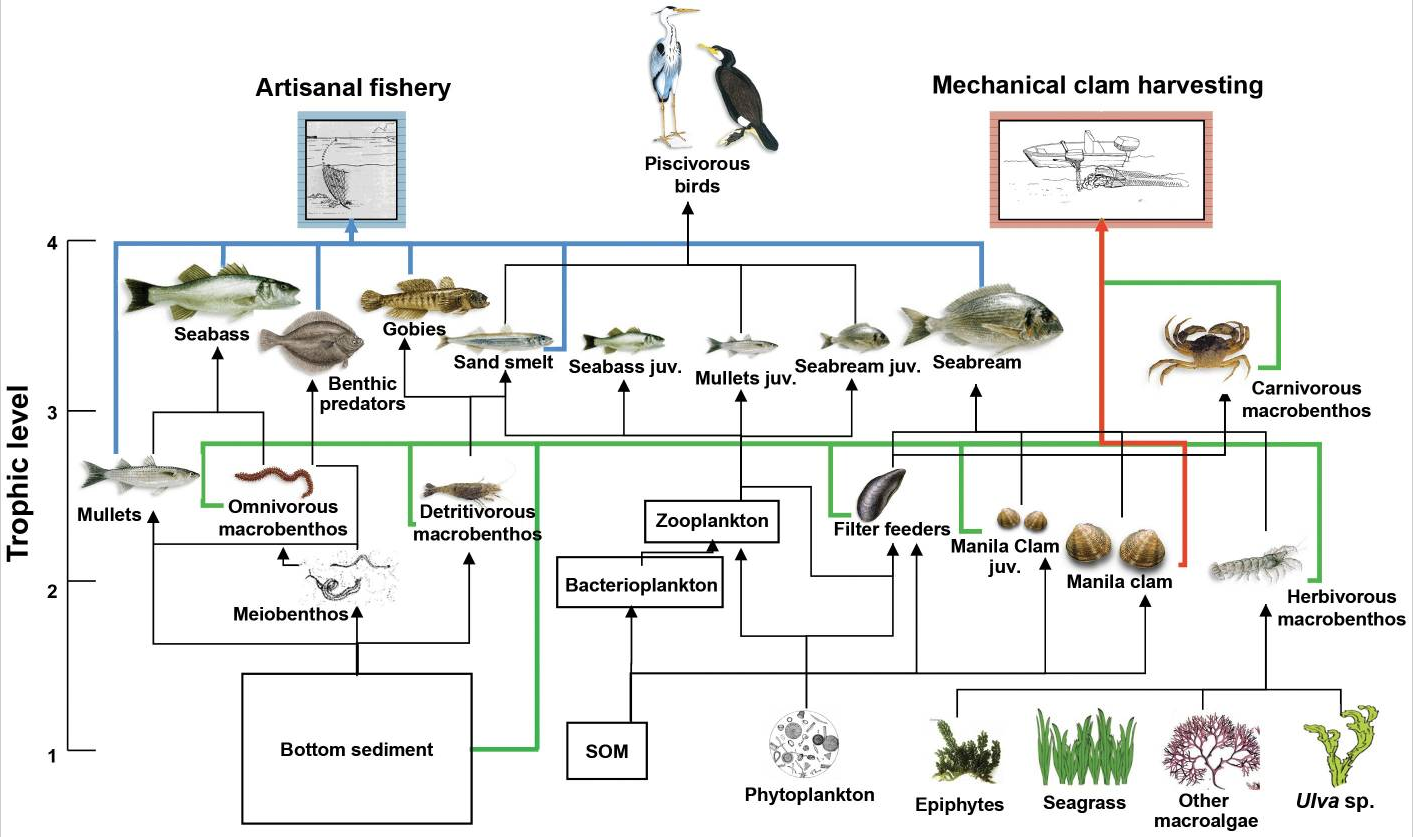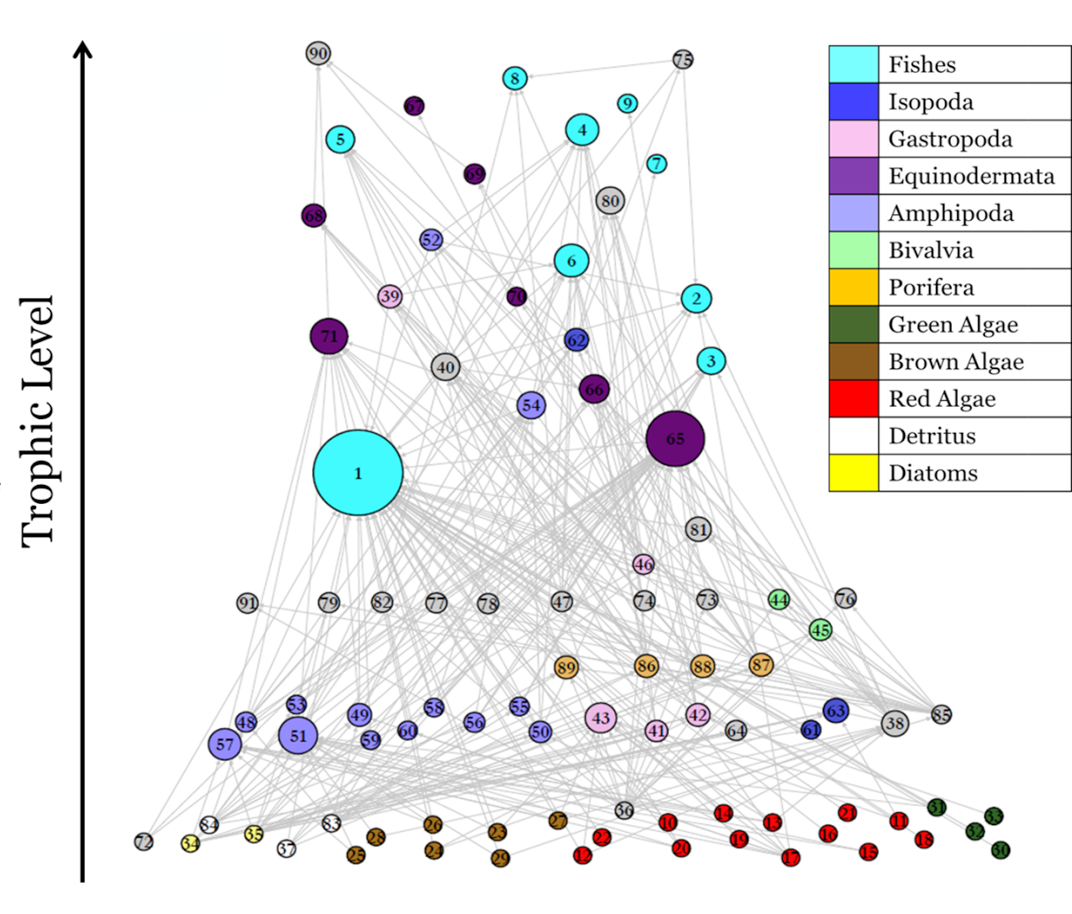Draft:Food Web Modeling
 | Review waiting, please be patient.
This may take 2 months or more, since drafts are reviewed in no specific order. There are 1,283 pending submissions waiting for review.
Where to get help
How to improve a draft
You can also browse Wikipedia:Featured articles and Wikipedia:Good articles to find examples of Wikipedia's best writing on topics similar to your proposed article. Improving your odds of a speedy review To improve your odds of a faster review, tag your draft with relevant WikiProject tags using the button below. This will let reviewers know a new draft has been submitted in their area of interest. For instance, if you wrote about a female astronomer, you would want to add the Biography, Astronomy, and Women scientists tags. Editor resources
Reviewer tools
|
A food web model is a simplified version of the interactions between organisms and their ecosystem. Ultimately depicting how everything in an ecosystem is interconnected, changing one aspect of the model affects all other components, just on different scales. These differ from simple food chains, as they follow more than one organisms' path or eating habits. Food web modeling involves more complex processes that go beyond just the energy transfer between trophic levels we see in a typical food web graphic. [1]

Modeling in general, can be very useful for oceanographic researchers as we have limited resources when it comes to collecting data over large spatial and temporal scales. By using a model, researchers can take the relatively "small" amount of accessible data in order to make predictions in regards to large scales problems.[2] It is important to note that while, models are highly useful tools they also included uncertainties and probabilities. They are but a snapshot of reality that allows humans to pull out useful information, such as patterns in shark feeding habits. Models are make assumptions, and are therefore limited.[3] To check a model's accuracy researchers can compare to baseline data or other models.
Food web models can be used to support ocean research and ecosystem management in many ways by creating a possible picture of an ecosystem. Scientists can use this picture to predict changes in the environment after a disturbance, such as hurricanes and other storms. These models can be used to help protect specific marine animals by showing how an individual species is likely to be affected in different scenarios. Lastly, food web models allow scientists to better understand the health of the whole oceanic ecosystem.
Food web models can take on many different forms. They may be in the form of a mathematical equation. They may be represented by a physical model, such as an experimental tank filled with various components of a real marine food web. Simulation software is a heavily utilized form for food web models as they can be adapted to test various issues on a food web. Simulated food web models however require a great deal of data on multiple aspects of an ecosystem, which can take a great deal of time, money, and cooperation amongst researchers. Most model variations fall under two main categories: deterministic or stochastic models. Deterministic models are based on known values and inputs that can be used to make predictions about a system. While stochastic models use random or unknown values to model a system. A brief list of examples of models used to examine food web dynamics are listed below. [4]
Food Web Model Techniques
1) Simple Linear Regression
- Mathematical model
- Used to look at the relationship between two variables
- An independent and dependent variable [5]
2) NPZD
- Nutrients-Phytoplankton - Zooplankton - Detritus
- Typical oceanographic food web model
- Variables are the stocks of N, P, Z, and D
- The relationships amongst these stocks are expressed as equations
- Can compare against observational data or place into more complex models[6]
3) ERSEM
- European Region Seas Ecosystem Model
- Incorporates marine biogeochemical cycles into an ecosystem model
- Aids in describing nutrient cycles in open ocean and benthic systems[7]
4) ECOPATH
- An ecosystem modeling software
- Static mass balanced snapshot of an ecosystem
- Can be combined with other software packages to include space and time components
- Used to explore the impact of disturbances
- Used to determine the ideal placement of protected areas[8]
5) Simulations
- When mathematical equations are not an option to describe natural systems
6) Individual Based (IBMs)
- Track individuals and their behaviors
- Simulate how individual traits impact communities
- Often used to model endangered populations[9]

Applications of Models
- Management plans
- Research approaches
- Test hypotheses
- Compare model to field data
- Simulate potential outcomes
- Identify relationships between parts of a system
- Synthesize data
- Make predictions
References
[edit]- ^ van der Heijden, L. H. (2020). "Quantitative food web modeling unravels the importance of the microphytobenthos-meiofauna pathway for a high trophic transfer by meiofauna in soft-bottom intertidal food webs". Ecological Modelling. 430. Elsevier: 1–16. doi:10.1016/j.ecolmodel.2020.109129. PMC 9238397. PMID 35769867.
- ^ Obelcz, Jeffrey. "Predictive Modeling and Ocean Exploration". ocean explorer NOAA. NOAA. Retrieved 3 October 2024.
- ^ Stone, Peter. "Climate Predictions: The Limits of Ocean Models" (PDF). Global Change. MIT. Retrieved 3 October 2024.
- ^ Townsend, Lee. "Deterministic vs Stochastic models: A guide to forecasting for pension plan sponsors". Milliman. Retrieved 3 October 2024.
- ^ Hayes, Adam. "Multiple Linear Regression (MLR) Definition, Formula, Examples". Investopedia. Retrieved 3 October 2024.
- ^ Anderson, T. R. "EMPOWER-1.0: an Efficient Model of Planktonic ecosystems Written in R". Research Gate. Geoscientific Model Development. Retrieved 3 October 2024.
- ^ "What is ERSEM?". The ERSEM Model. PML Modeling Group. Retrieved 3 October 2024.
- ^ "Ecopath with ecoism". ECOPATH. ECOPATH International Initiative. Retrieved 8 October 2024.
- ^ Grimm, Volker (2019). Ecological Models: Individual-Based Models. Elsevier. pp. 65–73. doi:10.1016/B978-0-12-409548-9.11144-3. ISBN 978-0-444-64130-4. Retrieved 3 October 2024.


